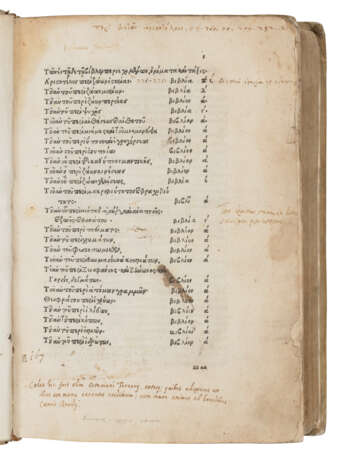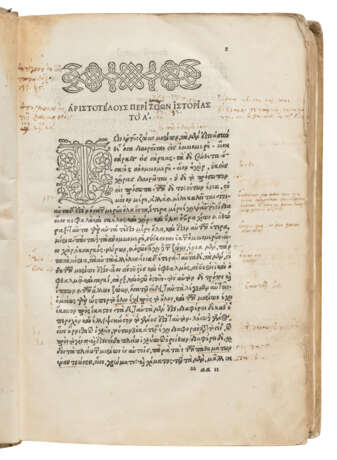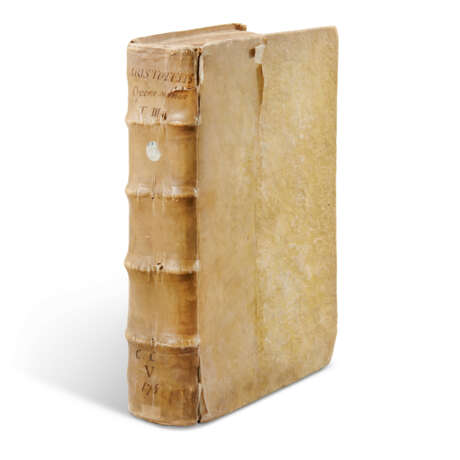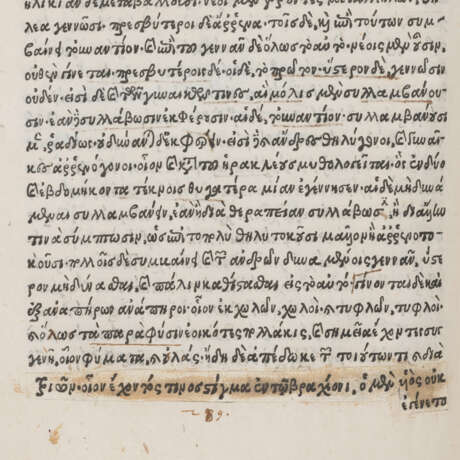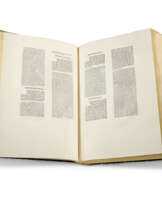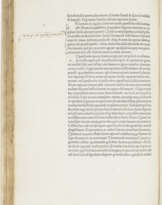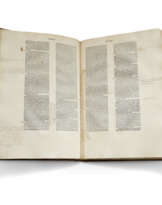ID 794504
Lot 79 | ARISTOTELES (384-322 B.C.E.)
Valeur estimée
£ 18 000 – 25 000
[Opera. Vol. III:] De animalibus [et alia]. Venice: Aldus Manutius, 1497.
Third volume of the celebrated editio princeps of the works of Aristotle, concerning the animal world, extensively annotated by the Milanese scholar Ottaviano Ferrari (1518-1586). Part of the most important Greek-printing project of the 15th century, and the greatest achievement in Aldus's Greek publishing programme, the Aldine edition restored to posterity the works of Aristotle in the pure original Greek. This copy extraordinarily retains the original strip pasted by Aldus at foot of f.100v (kkxv) to supply a missing line, like George III’s copy at the British Library, and in a few others. The colophon is the corrected variant, as per the Cracherode copy at the BL. The final unfoliated gathering *8 is present here, being a fragment of the 10th book of Historia Animalium, added by Aldus at a very late stage, and not found in all copies.
There are extensive scholarly Greek and Latin annotations probably by Ottaviano Ferrari (1518-1586), whose signature appears on the title, as well as by other hands. Ferrari read humanities at the Canobian schools in Milan and, for a short time, taught logic at the University of Pavia. The Aldine press published his De disciplina Encyclio in 1560, which is a valuable introduction to Aristotelian philosophy. Ferrari was an important collector of Greek manuscripts, as well as a student of medicine, so this work on the world of animals overlapped with his interests. This copy was acquired by a pupil of Ferrari, Cesare Rovida (c.1559-1591/4), bibliophile and professor of medicine in Pavia. According to an inscription on the first leaf, Rovida’s heirs sold this book to another Italian collector, who notes his belief that the annotations were likely by Ferrari. HC *1657; GW 2334; BMC V, 555-6; IGI 791; CIBN A-504; BSB-Ink A-698; Bod-inc A-384; Flodr 19:1 (Aristoteles); Klebs 83.1; PMM 38; Goff A-959.
Super-chancery (311 x 205mm). 466 leaves (of 467, lacking blank XX8, but with f.400 bis i.e. extra leaf PP1). Type: 1:146Gk, 2:114R. Woodcut floral and interlace headpieces and Greek initials (first leaf lightly soiled and frayed at fore-edge, f.152 with blank lower corner chipped, 8 leaves ff.252-259 with skilfully repaired tears to upper inner corner, these mostly marginal and without loss of text, ff. 171 and 364 with small marginal tears without loss, occasional light staining, mainly confined to margins, last gathering with light central stain and some marginal staining). 17th/18th-century vellum over thin pasteboard, vellum backstrip overlaid (backstrip cracked and split at head and tail of upper joint, extremities lightly rubbed). Provenance: annotations in an early hand – Ottaviano Ferrari (1518-1586; ownership inscription on first leaf) – early shelfmark and late sixteenth-century owner’s annotation on first leaf confirming the volume was purchased from Cesare Rovida’s heirs – later table of contents on front flyleaf – bibliographical inscriptions (inaccurate) on front pastedown.
Special notice
No VAT on hammer price or buyer's premium.
| Artiste: | Aristote (384 avant J.-C. - 322 avant J.-C.) |
|---|---|
| Lieu d'origine: | Italie, Europe |
| Catégorie maison de vente aux enchères: | Livres anciens, Livres imprimés |
| Artiste: | Aristote (384 avant J.-C. - 322 avant J.-C.) |
|---|---|
| Lieu d'origine: | Italie, Europe |
| Catégorie maison de vente aux enchères: | Livres anciens, Livres imprimés |
| Adresse de l'enchère |
CHRISTIE'S 8 King Street, St. James's SW1Y 6QT London Royaume-Uni | |
|---|---|---|
| Aperçu |
| |
| Téléphone | +44 (0)20 7839 9060 | |
| Commission | see on Website | |
| Conditions d'utilisation | Conditions d'utilisation |

